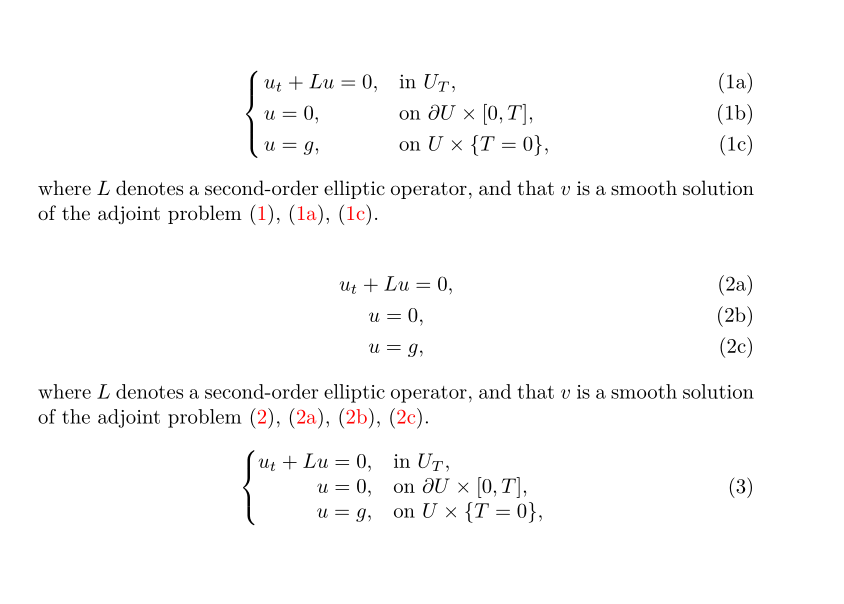```tex
\documentclass[a4paper,UTF8,twoside]{article}
\usepackage{amsmath}
\usepackage[colorlinks=true]{hyperref}
\usepackage[amsstyle]{cases}
\begin{document}
\begin{subnumcases}{\label{equ:utLu0inUT}}
u_t+Lu=0, &\text{in } U_T,\label{subequ:utLu0in}\\
u=0, &\text{on } \partial U\times [0,T],\label{subequ:u0on}\\
u=g, &\text{on } U\times\{T=0\},\label{subset:ugonUtimesT0}
\end{subnumcases}
where $L$ denotes a second-order elliptic operator, and that $v$ is a smooth solution of the adjoint problem \eqref{equ:utLu0inUT}, \eqref{subequ:utLu0in}, \eqref{subset:ugonUtimesT0}.
\begin{subequations}\label{equ:utLu0}
\begin{gather}
u_t+Lu=0,\label{subequ:utLu0}\\
u=0,\label{subequ:u0}\\
u=g,\label{subequ:ug}
\end{gather}
\end{subequations}
where $L$ denotes a second-order elliptic operator, and that $v$ is a smooth solution of the adjoint problem \eqref{equ:utLu0}, \eqref{subequ:utLu0}, \eqref{subequ:u0}, \eqref{subequ:ug}.
\begin{equation}
\left\{\!\!\!
\begin{array}{rl}
u_t+Lu=0, &\text{in } U_T,\\
u=0, &\text{on } \partial U\times [0,T],\\
u=g, &\text{on } U\times\{T=0\},
\end{array}\right.
\end{equation}
\end{document}
```
请问如何实现这样的效果,左侧是大括号(类似于cases环境),中间第一列右对齐,第二列左对齐,整个环境使用一个编号,然后每行各自有子编号。
如上图,第一个式子使用了cases包中的subnumcases环境,这个环境基本实现了上面的要求,但是却不满足第一列右对齐这一点。第二个式子使用了subequations环境,主要目的是为了展示编号的使用情况。第三个式子则是使用了array环境,但是却无法实现每行分别编号且为子编号这一点。
